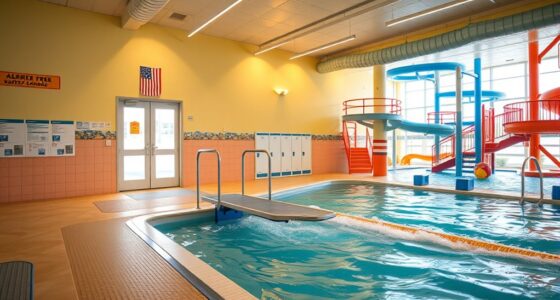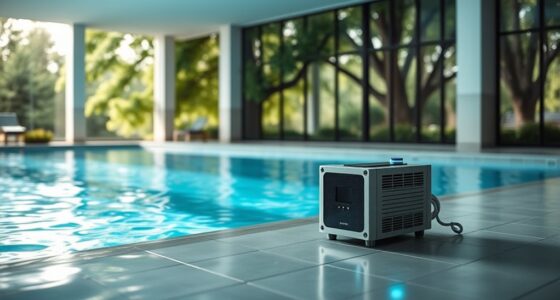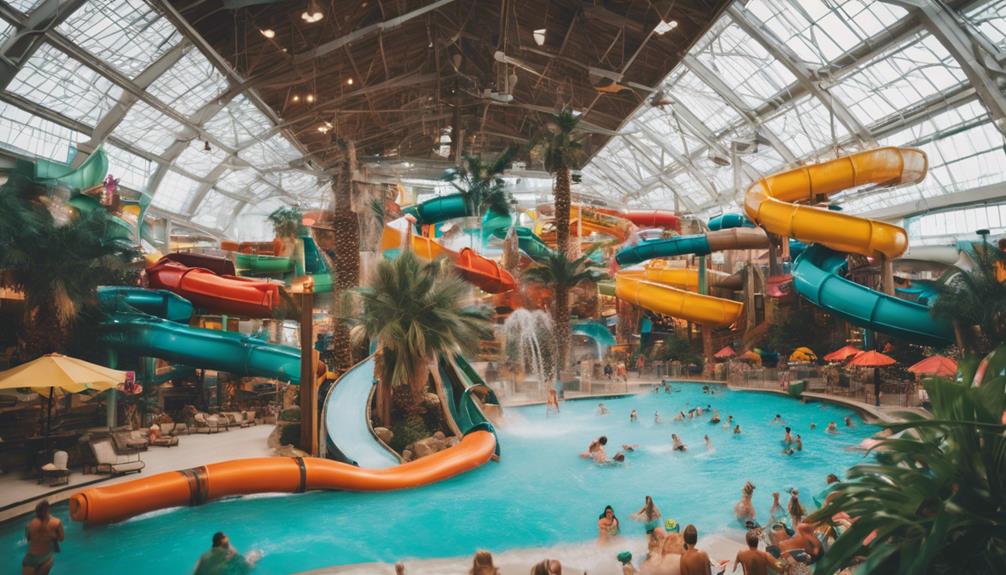At indoor water parks, you’ll find life jackets are often required for young children based on age and height. Most parks provide free, U.S. Coast Guard-approved jackets for guests, especially for those under 48 inches tall, and staff enforce these rules to keep everyone safe. Different parks may have varying policies or provide different types of jackets. Stay tuned to discover specific regulations and tips for ensuring your child’s safety during your visit.
Key Takeaways
- Indoor water parks typically require children under certain heights or ages to wear free, U.S. Coast Guard-approved life jackets.
- Parks provide accessible, complimentary life jackets, often located at entry points, pool areas, or designated stations.
- Approved life jackets include Type I, II, and III devices; non-approved flotation aids are usually not permitted.
- Staff enforce life jacket rules through signage, supervision, and announcements, with penalties for non-compliance.
- Regulations vary by region, with some parks encouraging personal vests and others supplying all necessary safety equipment.
Mandatory Use of Life Jackets for Young Children
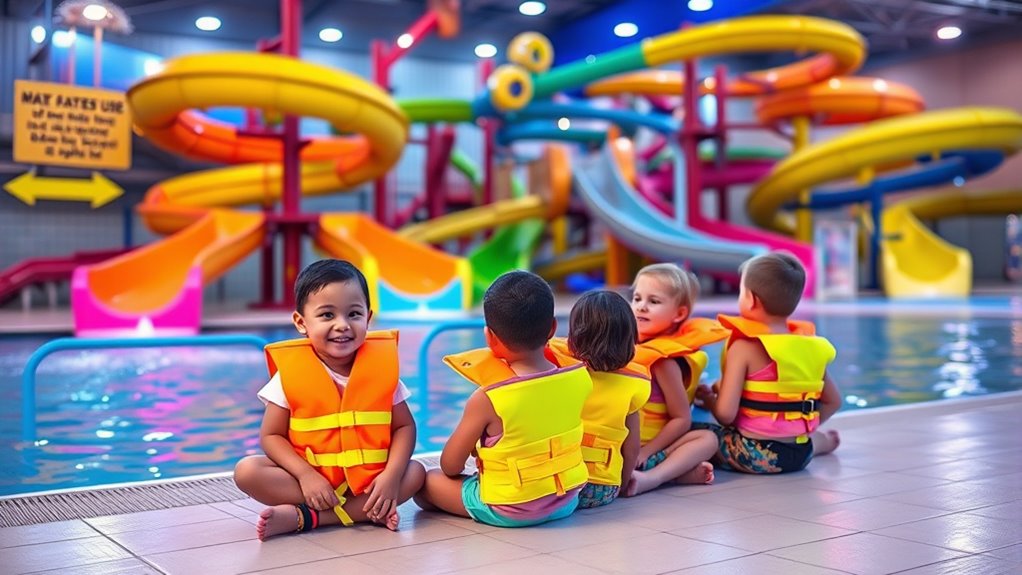
To guarantee young children stay safe in indoor water parks, many venues require the mandatory use of life jackets for certain age and height groups. If your child is under a specific age, like 48 inches, they’ll need a life jacket before entering pools or attractions. Height restrictions are also common; for example, children below 42 inches often must wear a life jacket in wave pools. Even with a life jacket on, supervision by a capable adult who can swim remains essential. Parks typically provide free, U.S. Coast Guard-approved life jackets, or you can bring your own, which must meet safety standards. Always check the park’s policies, as some attractions may have additional rules based on age or height to keep kids safe. State laws often specify requirements for life jacket use, so it’s helpful to be familiar with local regulations to ensure compliance.
Types of Approved Life Jackets and Safety Standards
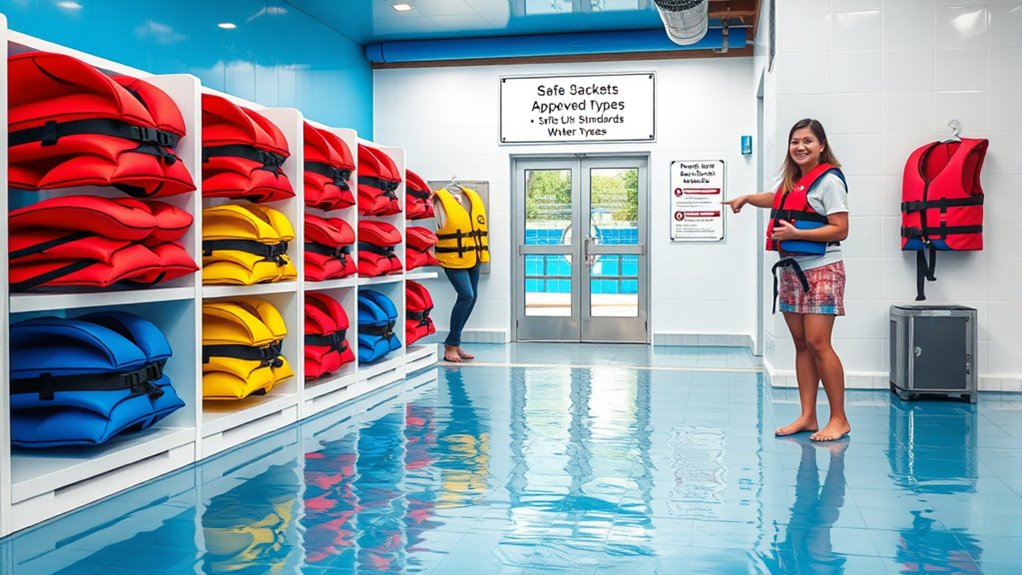
Understanding the different types of approved life jackets helps you choose the safest option for various water activities. Type I (Offshore) jackets offer high buoyancy and can turn unconscious wearers face up, making them ideal for rough or remote waters, though they’re bulky and less comfortable. Type II (Near-Shore) vests are less bulky, suited for calmer inland waters, but don’t reliably turn wearers face up. Type III (Flotation Aids) are popular for water sports; they’re comfortable and allow good mobility but don’t guarantee face-up positioning when unconscious. Type IV devices, like cushions and rings, are throwable and not wearable. Hybrid inflatable jackets combine buoyancy with automatic inflation, but they require maintenance and aren’t suitable for activities with expected immersion. Always choose a jacket that meets safety standards and is appropriate for your water activity. Additionally, understanding safety standards helps ensure the life jacket you select provides the necessary protection and compliance.
Locations to Access Life Jackets at Water Parks
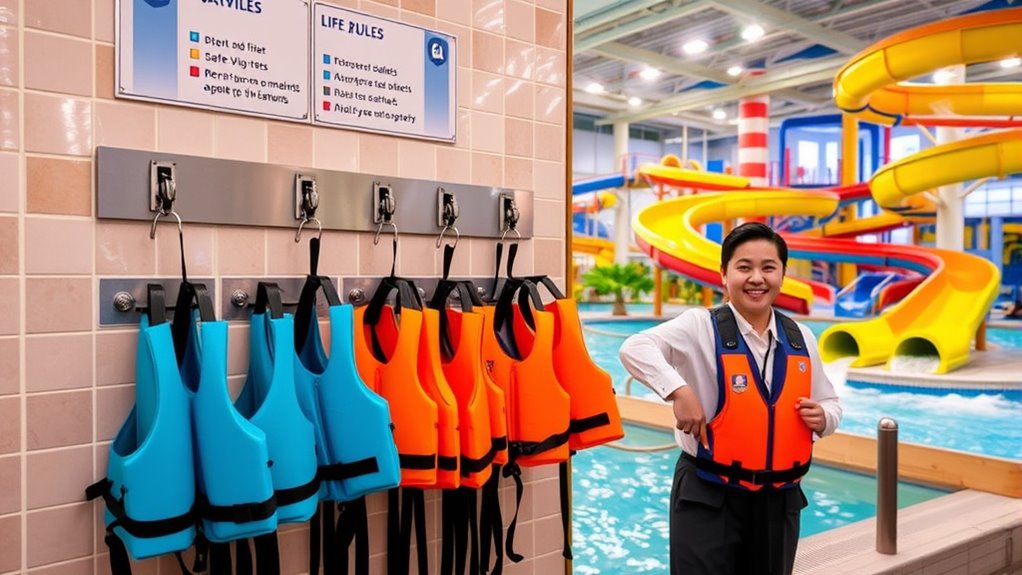
Ever wondered where to find life jackets at water parks? Most parks offer them free of charge. For example, Water-Zoo Indoor Water Park provides life jackets throughout the park, making them easily accessible. Oceans of Fun also offers complimentary life jackets at various locations for guests of all ages. Great Wolf Lodge includes them as part of their amenities, ensuring availability in the water park area. Kalahari Resort encourages guests to bring their own Coast Guard-approved vests but has some available for use. On the other hand, Gold Rush Waterpark does not provide life jackets; guests must bring their own Coast Guard-approved vests. Remember, these locations prioritize safety, so always check where life jackets are available before enjoying the water attractions. Most parks provide life jackets for free, ensuring all guests can enjoy water activities safely.
Regulations and Enforcement of Life Jacket Rules

Regulations and enforcement play a crucial role in ensuring water park safety by making sure everyone follows life jacket rules. Staff supervise guests to confirm adherence, while signage and announcements remind everyone of requirements. Educational materials help inform you about the importance of using life jackets, especially if you’re under 48 inches or a weak swimmer. Penalties for non-compliance can include removal from certain areas, emphasizing safety’s seriousness. Properly fitting life jackets, maintained in good condition, are essential for effectiveness. Operators follow industry standards, manufacturer guidelines, and conduct regular inspections to meet safety criteria. Enforcement ensures liability is minimized and safety is prioritized. Properly fitting life jackets and their maintenance are vital components of effective safety protocols.
Variations in State Laws and Regional Policies
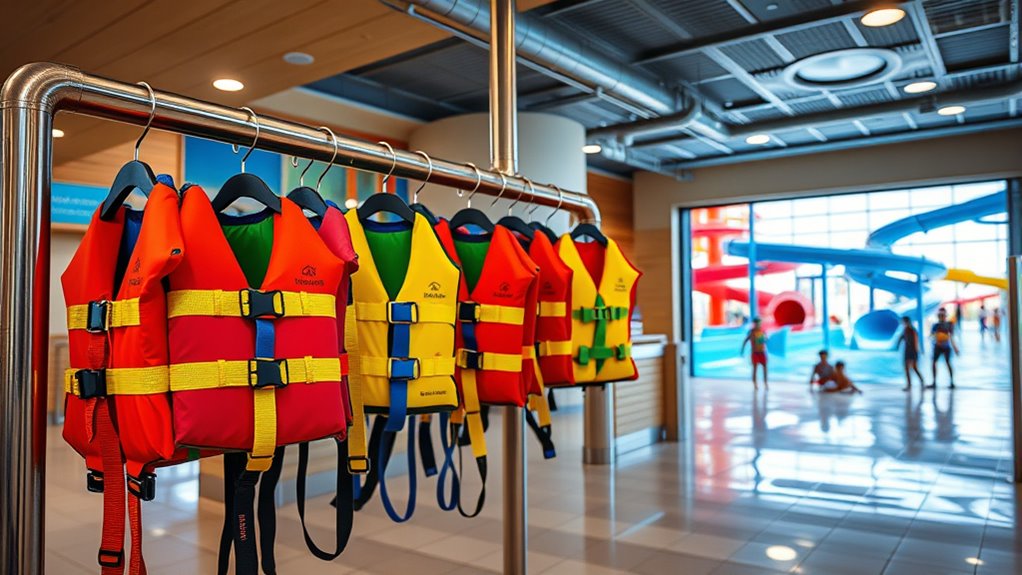
State laws and regional policies vary widely when it comes to indoor water park life jacket requirements, often reflecting local water activities and safety priorities. Many states mandate children under specific ages—ranging from 8 to 13—to wear life jackets on vessels or during water activities, with certain exceptions for adults or enclosed areas. Some states default to Coast Guard rules, requiring children under 13 to wear jackets on moving boats. Indoor water parks’ policies differ regionally; many require life jackets for small children or those under a certain height, often under 48 inches. Parks may provide free Coast Guard-approved devices or restrict non-approved flotation aids. Enforcement and penalties vary, with fines from $25 to over $500, and rules are often stricter at indoor parks than state minimums, influenced by local climate and water activity focus. Moreover, creativity in safety protocols can lead to innovative solutions for enhancing guest safety and engagement within these environments.
Frequently Asked Questions
Are There Size Restrictions for Life Jackets Offered at Water Parks?
Yes, there are size restrictions for life jackets at water parks. You’ll find that only U.S. Coast Guard-approved jackets are permitted, and they come in various sizes to fit different ages and body types. The park provides these jackets for free, but make sure to select one that fits properly for safety. Staff may inspect your jacket to verify it meets regulations, so don’t forget to check the fit before entering the water.
Can Guests Bring Their Own Life Jackets Into Indoor Water Parks?
Did you know that nearly 80% of water park accidents involve guests not wearing life jackets? You can bring your own, but only if it’s U.S. Coast Guard approved. Make sure it fits well, is in good condition, and doesn’t have metal parts. Many parks allow personal life jackets at entry and on certain rides, but always check specific rules to keep everyone safe and compliant.
How Often Are Water Park Life Jackets Inspected for Safety Compliance?
You should expect water park life jackets to be inspected regularly for safety compliance. Typically, staff perform monthly self-checks and pre-use inspections to ensure they’re in good condition. Additionally, professional servicing is recommended annually, especially for inflatable models, to verify proper inflation mechanisms and hardware. These routine inspections help identify wear, damage, or malfunctions early, guaranteeing your safety when enjoying the water park attractions.
Are There Age or Weight Limits for Using Water Park Life Jackets?
Think of life jackets as the safety net that catches you when you’re too high up in the water park’s roller coaster of fun. You’ll find that most parks set age limits—usually under 8 or 10—and weight restrictions, often around 200 pounds, to make sure everyone stays safe. These limits help prevent accidents and keep the water adventure enjoyable for everyone, no matter their size or age.
Do Indoor Water Parks Provide Life Jackets for Guests With Special Needs?
Yes, indoor water parks provide free life jackets for guests with special needs. You can usually find these at main entrances, lifeguard stations, or designated safety areas throughout the park. Staff often accommodate guests by offering Coast Guard-approved jackets, ensuring safety and comfort. If you prefer, you’re also welcome to bring your own approved life jacket. Just remember, staff may require you to wear a life jacket for certain attractions or in specific areas.
Conclusion
Remember, safety comes first, especially for young children. Always guarantee they wear approved life jackets and know where to find them in the water park. For example, imagine a family who neglected to grab a life jacket, only to face a sudden emergency. By following the rules and staying prepared, you can help prevent accidents and enjoy a fun, worry-free day. Prioritize safety, and everyone can make the most of your water park adventure.




